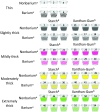Respiratory-Swallow Coordination in Healthy Adults During Drinking of Thin to Extremely Thick Liquids: A Research Note
- PMID: 32109178
- PMCID: PMC7229706
- DOI: 10.1044/2019_JSLHR-19-00163
Respiratory-Swallow Coordination in Healthy Adults During Drinking of Thin to Extremely Thick Liquids: A Research Note
Abstract
Purpose Respiratory-swallow coordination is vital for airway protection, preventing aspiration, or penetration of foreign material into the airway. With the implementation of the International Dysphagia Diet Standardization Initiative definitions for different liquid consistencies used in dysphagia management, it is important to establish whether respiratory-swallow coordination patterns differ across these consistencies. This study aimed to evaluate respiratory behaviors during swallowing across the spectrum from thin to extremely thick liquids in healthy adults less than 60 years of age. Method Thirty healthy adults, aged 21-55 years, each consumed 54 naturally sized cup sips or spoonfuls of liquid stimuli prepared in thin, slightly thick, mildly thick, moderately thick, and extremely thick consistencies. Half of the stimuli were prepared using barium and half with a lemon-flavored water. Concurrent respiratory and swallowing pressure signals were collected to evaluate the respiratory phase pattern and pause duration associated with the swallow. Results An expiration-swallow-expiration pattern was the dominant respiratory phase pattern, observed in 92.7% of the trials, with no significant effect of consistency. Respiratory pause duration was found to be significantly shorter with barium stimuli (0.73 s) compared to nonbarium stimuli (0.78 s) (p < .001, Cohen's d = .2), with no notable effects based on the factors of sex or liquid consistency. Conclusions In a convenience sample of healthy adults under the age of 60 years, consistent respiratory-swallow phasing and stable timing across the spectrum from thin to extremely thick liquids was observed. The data from this study can serve as preliminary reference data to which assessment information for individuals with dysphagia or respiratory challenges can be compared.
Figures



References
-
- Boden K., Cedborg A. I., Eriksson L. I., Hedström H. W., Kuylenstierna R., Sundman E., & Ekberg O. (2009). Swallowing and respiratory pattern in young healthy individuals recorded with high temporal resolution. Neurogastroenterology and Motility, 21(11), 1163–e101. https://doi.org/10.1111/j.1365-2982.2009.01352.x - PubMed
-
- Brodsky M. B., McFarland D. H., Dozier T. S., Blair J., Ayers C., Michel Y., Gillespie M. B., Day T. A., & Martin-Harris B. (2010). Respiratory-swallow phase patterns and their relationship to swallowing impairment in patients treated for oropharyngeal cancer. Head & Neck, 32(4), 481–489. https://doi.org/10.1002/hed.21209 - PMC - PubMed
-
- Cichero J. A. Y., Lam P., Steele C. M., Hanson B., Chen J., Dantas R. O., Duivestein J., Kayashita J., Lecko C., Murray J., Pillay M., Riquelme L., & Stanschus S. (2017). Development of international terminology and definitions for texture-modified foods and thickened fluids used in dysphagia management: The IDDSI Framework. Dysphagia, 32(2), 293–314. https://doi.org/10.1007/s00455-016-9758-y - PMC - PubMed
-
- Clavé P., De Kraa M., Arreola V., Girvent M., Farre R., Palomera E., & Serra-Prat M. (2006). The effect of bolus viscosity on swallowing function in neurogenic dysphagia. Alimentary Pharmacology & Therapeutics, 24(9), 1385–1394. https://doi.org/10.1111/j.1365-2036.2006.03118.x - PubMed
-
- Garcia J. M., Chambers E. IV, & Molander M. (2005). Thickened liquids: Practice patterns of speech-language pathologists. American Journal of Speech-Language Pathology, 14(1), 4–13. https://doi.org/10.1044/1058-0360(2005/003) - PubMed
Publication types
MeSH terms
Substances
Grants and funding
LinkOut - more resources
Full Text Sources
Medical

